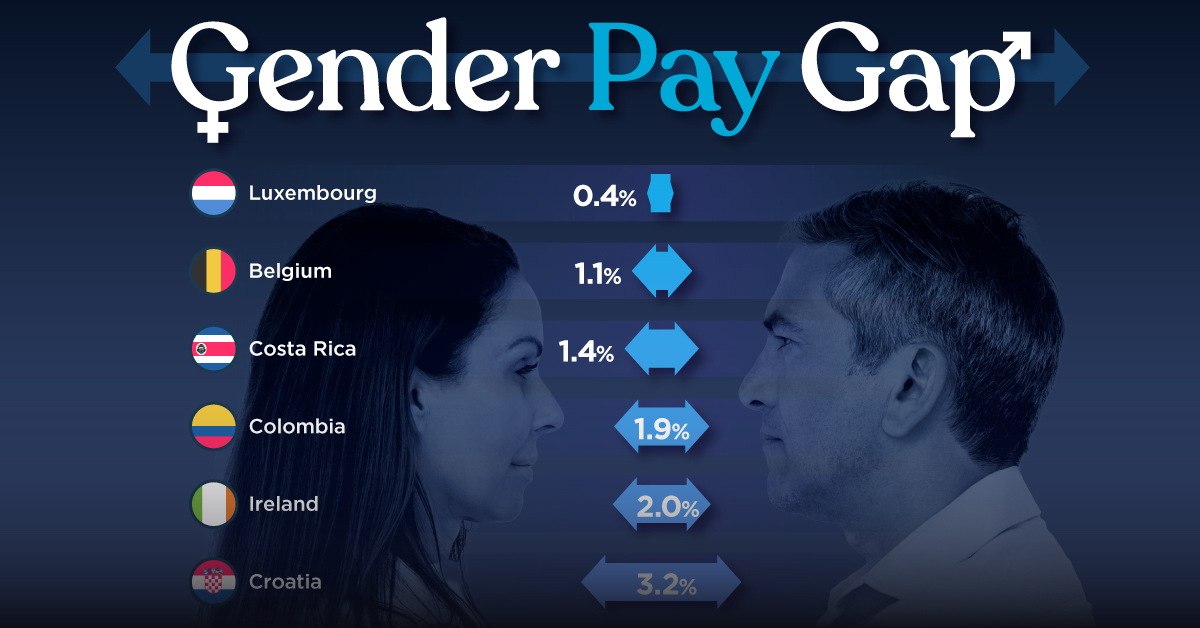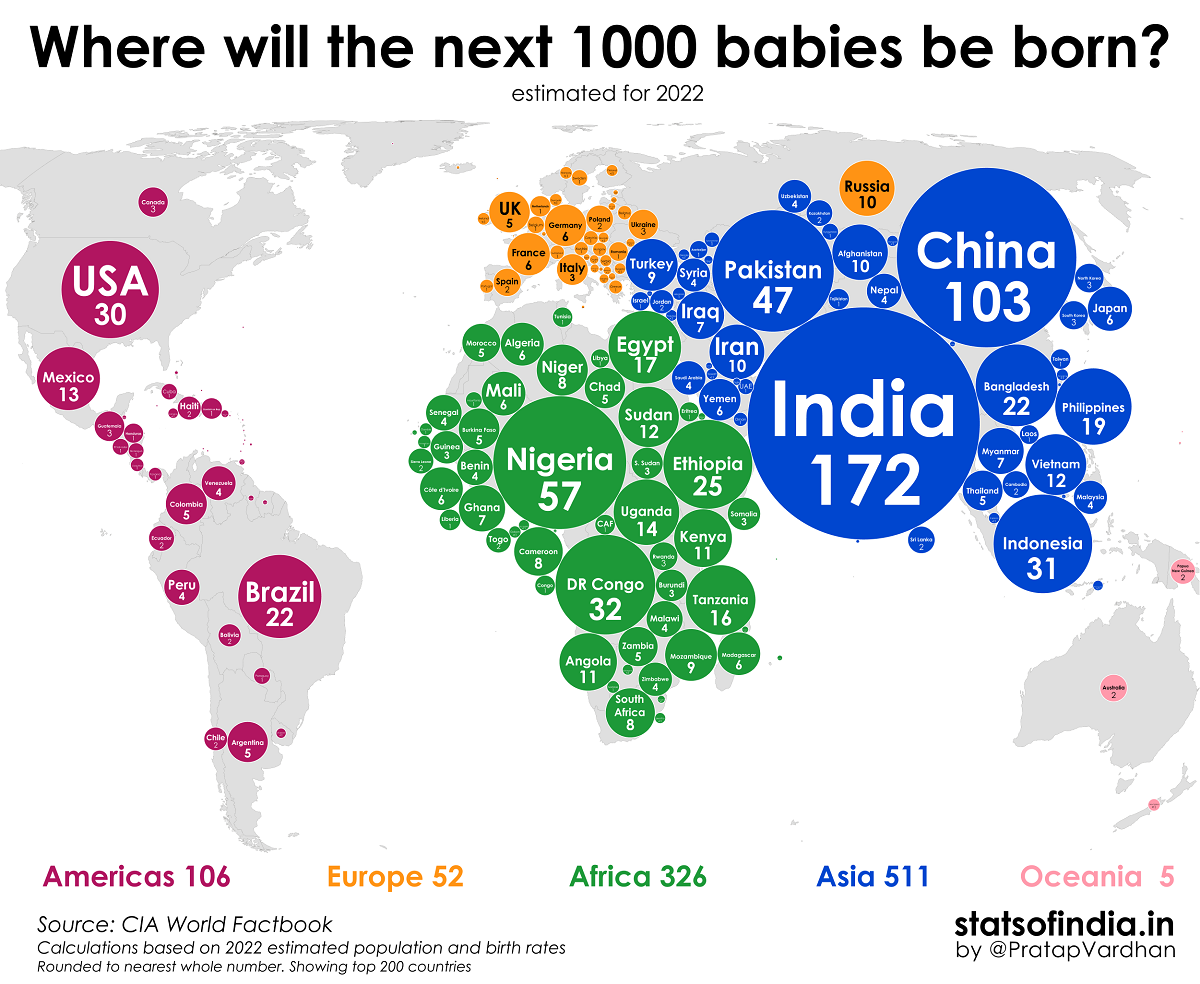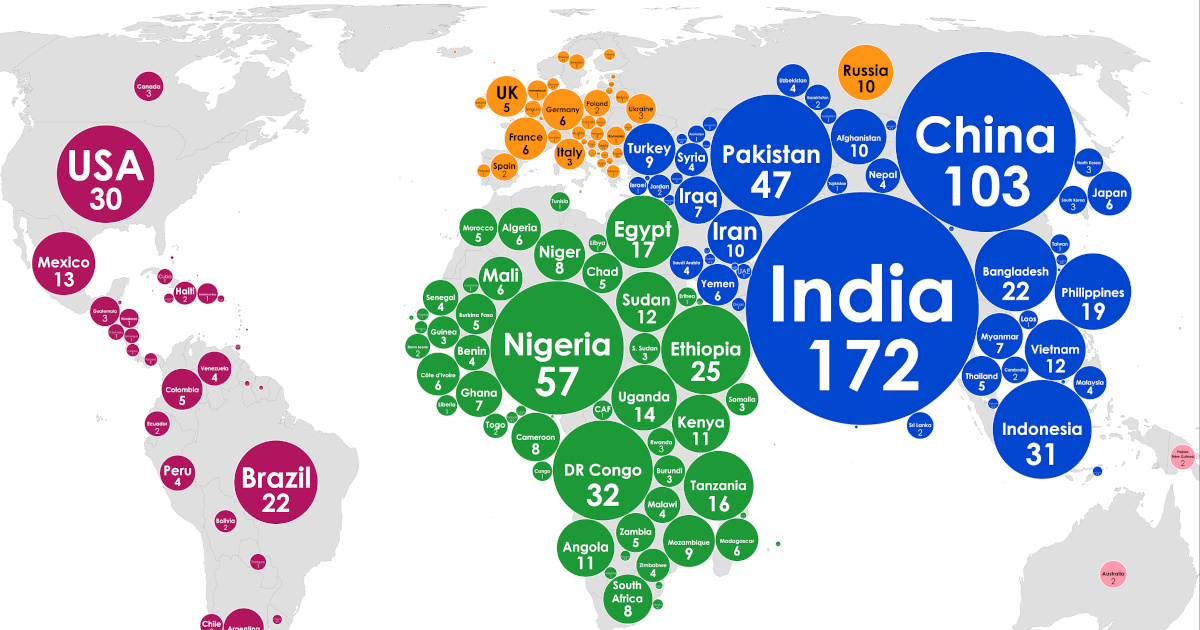Demographics
Where Will the World’s Next 1,000 Babies Be Born?
View a higher resolution version of this map.
Where Will the World’s Next 1,000 Babies Be Born?
View a higher resolution version of this map.
Every four minutes, approximately 1,000 babies are born across the globe. But in which countries are these babies the most statistically likely to come from?
Using data from the CIA World Factbook, this graphic by Pratap Vardhan (Stats of India) paints a picture of the world’s demographics, showing which countries are most likely to welcome the next 1,000 babies based on population and birth rates as of 2022 estimates.
The Next 1,000 Babies, By Country
Considering India has a population of nearly 1.4 billion, it’s fairly unsurprising that it ranks first on the list. Of every 1,000 babies born, the South Asian country accounts for roughly 172 of them.
| Place | Region | Births Per 1,000 Global Babies |
|---|---|---|
| 🇮🇳 India | Asia | 171.62 |
| 🇨🇳 China | Asia | 102.84 |
| 🇳🇬 Nigeria | Africa | 56.50 |
| 🇵🇰 Pakistan | Asia | 47.23 |
| 🇨🇩 Congo, Democratic Republic of the | Africa | 31.90 |
| 🇮🇩 Indonesia | Asia | 31.20 |
| 🇺🇸 United States | Americas | 30.42 |
| 🇪🇹 Ethiopia | Africa | 25.44 |
| 🇧🇷 Brazil | Americas | 22.27 |
| 🇧🇩 Bangladesh | Asia | 21.52 |
| 🇵🇭 Philippines | Asia | 18.75 |
| 🇪🇬 Egypt | Africa | 16.98 |
| 🇹🇿 Tanzania | Africa | 15.61 |
| 🇺🇬 Uganda | Africa | 13.89 |
| 🇲🇽 Mexico | Americas | 12.85 |
| 🇻🇳 Vietnam | Asia | 11.96 |
| 🇸🇩 Sudan | Africa | 11.79 |
| 🇰🇪 Kenya | Africa | 10.82 |
| 🇦🇴 Angola | Africa | 10.68 |
| 🇦🇫 Afghanistan | Asia | 9.98 |
| 🇷🇺 Russia | Europe | 9.85 |
| 🇮🇷 Iran | Asia | 9.73 |
| 🇲🇿 Mozambique | Africa | 8.72 |
| 🇹🇷 Turkey | Asia | 8.71 |
| 🇳🇪 Niger | Africa | 8.46 |
| 🇿🇦 South Africa | Africa | 7.84 |
| 🇨🇲 Cameroon | Africa | 7.65 |
| 🇮🇶 Iraq | Asia | 7.34 |
| 🇬🇭 Ghana | Africa | 6.94 |
| 🇲🇲 Myanmar | Asia | 6.90 |
| 🇯🇵 Japan | Asia | 6.34 |
| 🇲🇱 Mali | Africa | 6.25 |
| 🇩🇿 Algeria | Africa | 6.01 |
| 🇨🇮 Cote d'Ivoire | Africa | 5.97 |
| 🇲🇬 Madagascar | Africa | 5.93 |
| 🇫🇷 France | Europe | 5.85 |
| 🇩🇪 Germany | Europe | 5.62 |
| 🇾🇪 Yemen | Asia | 5.61 |
| 🇨🇴 Colombia | Americas | 5.48 |
| 🇧🇫 Burkina Faso | Africa | 5.41 |
| 🇬🇧 United Kingdom | Europe | 5.37 |
| 🇹🇩 Chad | Africa | 5.34 |
| 🇦🇷 Argentina | Americas | 5.29 |
| 🇹🇭 Thailand | Asia | 5.19 |
| 🇿🇲 Zambia | Africa | 5.03 |
| 🇲🇦 Morocco | Africa | 4.70 |
| 🇲🇼 Malawi | Africa | 4.27 |
| 🇧🇯 Benin | Africa | 4.16 |
| 🇸🇳 Senegal | Africa | 4.15 |
| 🇵🇪 Peru | Americas | 4.08 |
| 🇳🇵 Nepal | Asia | 3.95 |
| 🇻🇪 Venezuela | Americas | 3.78 |
| 🇸🇦 Saudi Arabia | Asia | 3.69 |
| 🇿🇼 Zimbabwe | Africa | 3.67 |
| 🇲🇾 Malaysia | Asia | 3.62 |
| 🇸🇾 Syria | Asia | 3.60 |
| 🇺🇿 Uzbekistan | Asia | 3.55 |
| 🇬🇳 Guinea | Africa | 3.47 |
| 🇸🇴 Somalia | Africa | 3.45 |
| 🇧🇮 Burundi | Africa | 3.28 |
| 🇸🇸 South Sudan | Africa | 3.19 |
| 🇮🇹 Italy | Europe | 3.12 |
| 🇬🇹 Guatemala | Americas | 2.90 |
| 🇺🇦 Ukraine | Europe | 2.88 |
| 🇨🇦 Canada | Americas | 2.85 |
| 🇰🇵 Korea, North | Asia | 2.71 |
| 🇰🇷 Korea, South | Asia | 2.63 |
| 🇷🇼 Rwanda | Africa | 2.56 |
| 🇪🇸 Spain | Europe | 2.47 |
| 🇵🇱 Poland | Europe | 2.38 |
| 🇰🇭 Cambodia | Asia | 2.37 |
| 🇦🇺 Australia | Oceania | 2.36 |
| 🇱🇰 Sri Lanka | Asia | 2.35 |
| 🇰🇿 Kazakhstan | Asia | 2.19 |
| 🇪🇨 Ecuador | Americas | 2.09 |
| 🇸🇱 Sierra Leone | Africa | 2.06 |
| 🇵🇬 Papua New Guinea | Oceania | 2.04 |
| 🇹🇬 Togo | Africa | 1.99 |
| 🇯🇴 Jordan | Asia | 1.82 |
| 🇭🇹 Haiti | Americas | 1.76 |
| 🇨🇱 Chile | Americas | 1.73 |
| 🇧🇴 Bolivia | Americas | 1.65 |
| 🇱🇷 Liberia | Africa | 1.44 |
| 🇩🇴 Dominican Republic | Americas | 1.42 |
| 🇳🇱 Netherlands | Europe | 1.40 |
| 🇹🇯 Tajikistan | Asia | 1.39 |
| 🇨🇫 Central African Republic | Africa | 1.31 |
| 🇨🇬 Congo, Republic of the | Africa | 1.30 |
| 🇹🇼 Taiwan | Asia | 1.28 |
| 🇹🇳 Tunisia | Africa | 1.28 |
| 🇭🇳 Honduras | Americas | 1.24 |
| 🇪🇷 Eritrea | Africa | 1.23 |
| 🇷🇴 Romania | Europe | 1.19 |
| 🇱🇦 Laos | Asia | 1.19 |
| 🇮🇱 Israel | Asia | 1.14 |
| 🇱🇾 Libya | Africa | 1.13 |
| 🇦🇿 Azerbaijan | Asia | 1.03 |
| 🇧🇪 Belgium | Europe | 0.95 |
| 🇵🇾 Paraguay | Americas | 0.88 |
| 🇰🇬 Kyrgyzstan | Asia | 0.87 |
| 🇸🇻 El Salvador | Americas | 0.86 |
| 🇲🇷 Mauritania | Africa | 0.86 |
| 🇸🇪 Sweden | Europe | 0.83 |
| 🇨🇺 Cuba | Americas | 0.82 |
| 🇦🇪 United Arab Emirates | Asia | 0.79 |
| 🇳🇮 Nicaragua | Americas | 0.76 |
| 🇹🇲 Turkmenistan | Asia | 0.72 |
| 🇨🇿 Czechia | Europe | 0.68 |
| 🇨🇭 Switzerland | Europe | 0.65 |
| 🇧🇾 Belarus | Europe | 0.63 |
| 🇦🇹 Austria | Europe | 0.62 |
| 🇭🇺 Hungary | Europe | 0.62 |
| 🇴🇲 Oman | Asia | 0.61 |
| 🇵🇹 Portugal | Europe | 0.60 |
| 🇬🇷 Greece | Europe | 0.59 |
| 🇵🇦 Panama | Americas | 0.57 |
| 🇨🇷 Costa Rica | Americas | 0.55 |
| 🇬🇼 Guinea-Bissau | Africa | 0.54 |
| 🇵🇸 West Bank | Asia | 0.54 |
| 🇬🇲 Gambia | Africa | 0.51 |
| 🇱🇧 Lebanon | Asia | 0.51 |
| 🇳🇦 Namibia | Africa | 0.50 |
| 🇳🇴 Norway | Europe | 0.49 |
| 🇩🇰 Denmark | Europe | 0.49 |
| 🇮🇪 Ireland | Europe | 0.48 |
| 🇳🇿 New Zealand | Oceania | 0.47 |
| 🇬🇦 Gabon | Africa | 0.45 |
| 🇷🇸 Serbia | Europe | 0.44 |
| 🇭🇰 Hong Kong | Asia | 0.43 |
| 🇫🇮 Finland | Europe | 0.43 |
| 🇧🇬 Bulgaria | Europe | 0.41 |
| 🇵🇸 Gaza Strip | Asia | 0.41 |
| 🇰🇼 Kuwait | Asia | 0.40 |
| 🇬🇪 Georgia | Asia | 0.40 |
| 🇸🇬 Singapore | Asia | 0.39 |
| 🇲🇳 Mongolia | Asia | 0.38 |
| 🇱🇸 Lesotho | Africa | 0.37 |
| 🇬🇶 Equatorial Guinea | Africa | 0.37 |
| 🇸🇰 Slovakia | Europe | 0.36 |
| 🇧🇼 Botswana | Africa | 0.36 |
| 🇯🇲 Jamaica | Americas | 0.33 |
| 🇹🇱 Timor-Leste | Asia | 0.33 |
| 🇺🇾 Uruguay | Americas | 0.32 |
| 🇦🇱 Albania | Europe | 0.29 |
| 🇭🇷 Croatia | Europe | 0.27 |
| 🇲🇩 Moldova | Europe | 0.25 |
| 🇦🇲 Armenia | Asia | 0.24 |
| 🇧🇦 Bosnia and Herzegovina | Europe | 0.24 |
| 🇽🇰 Kosovo | Europe | 0.21 |
| 🇸🇿 Eswatini | Africa | 0.19 |
| 🇱🇹 Lithuania | Europe | 0.18 |
| 🇵🇷 Puerto Rico | Americas | 0.18 |
| 🇶🇦 Qatar | Asia | 0.17 |
| 🇲🇰 North Macedonia | Europe | 0.16 |
| 🇩🇯 Djibouti | Africa | 0.16 |
| 🇰🇲 Comoros | Africa | 0.14 |
| 🇧🇭 Bahrain | Asia | 0.14 |
| 🇸🇮 Slovenia | Europe | 0.13 |
| 🇱🇻 Latvia | Europe | 0.12 |
| 🇸🇧 Solomon Islands | Oceania | 0.12 |
| 🇫🇯 Fiji | Oceania | 0.11 |
| 🇹🇹 Trinidad and Tobago | Americas | 0.11 |
| 🇧🇹 Bhutan | Asia | 0.10 |
| 🇨🇾 Cyprus | Asia | 0.10 |
| 🇬🇾 Guyana | Americas | 0.10 |
| 🇲🇺 Mauritius | Africa | 0.09 |
| 🇨🇻 Cabo Verde | Africa | 0.08 |
| 🇪🇪 Estonia | Europe | 0.08 |
| 🇸🇷 Suriname | Americas | 0.07 |
| 🇧🇿 Belize | Americas | 0.06 |
| 🇧🇳 Brunei | Asia | 0.06 |
| 🇱🇺 Luxembourg | Europe | 0.06 |
| 🇲🇪 Montenegro | Europe | 0.05 |
| 🇻🇺 Vanuatu | Oceania | 0.05 |
| 🇸🇹 Sao Tome and Principe | Africa | 0.04 |
| 🇲🇻 Maldives | Asia | 0.04 |
| 🇲🇴 Macau | Asia | 0.04 |
| 🇧🇸 Bahamas, The | Americas | 0.04 |
| 🇮🇸 Iceland | Europe | 0.03 |
| 🇲🇹 Malta | Europe | 0.03 |
| 🇳🇨 New Caledonia | Oceania | 0.03 |
| 🇵🇫 French Polynesia | Oceania | 0.03 |
| 🇼🇸 Samoa | Oceania | 0.03 |
| 🇧🇧 Barbados | Americas | 0.02 |
| 🇬🇺 Guam | Oceania | 0.02 |
| 🇰🇮 Kiribati | Oceania | 0.02 |
| 🇹🇴 Tonga | Oceania | 0.02 |
| 🇨🇼 Curacao | Americas | 0.01 |
| 🇱🇨 Saint Lucia | Americas | 0.01 |
| 🇫🇲 Micronesia, Federated States of | Oceania | 0.01 |
| 🇲🇭 Marshall Islands | Oceania | 0.01 |
| 🇬🇩 Grenada | Americas | 0.01 |
| 🇦🇬 Antigua and Barbuda | Americas | 0.01 |
| 🇦🇼 Aruba | Americas | 0.01 |
| 🇯🇪 Jersey | Europe | 0.01 |
| 🇻🇨 Saint Vincent and the Grenadines | Americas | 0.01 |
| 🇻🇮 Virgin Islands | Americas | 0.01 |
| 🇸🇨 Seychelles | Africa | 0.01 |
| 🇩🇲 Dominica | Americas | 0.01 |
| 🇮🇲 Isle of Man | Europe | 0.01 |
| 🇧🇲 Bermuda | Americas | 0.01 |
| 🇲🇵 Northern Mariana Islands | Oceania | 0.01 |
| 🇬🇱 Greenland | Americas | 0.01 |
| 🇹🇨 Turks and Caicos Islands | Americas | 0.01 |
| 🇫🇴 Faroe Islands | Europe | 0.01 |
| 🇦🇸 American Samoa | Oceania | 0.01 |
| 🇰🇾 Cayman Islands | Americas | 0.01 |
| 🇰🇳 Saint Kitts and Nevis | Americas | 0.00 |
| 🇬🇬 Guernsey | Europe | 0.00 |
| 🇦🇩 Andorra | Europe | 0.00 |
| 🇸🇽 Sint Maarten | Americas | 0.00 |
| 🇲🇫 Saint Martin | Americas | 0.00 |
| 🇻🇬 British Virgin Islands | Americas | 0.00 |
| 🇬🇮 Gibraltar | Europe | 0.00 |
| 🇱🇮 Liechtenstein | Europe | 0.00 |
| 🇸🇲 San Marino | Europe | 0.00 |
| 🇹🇻 Tuvalu | Oceania | 0.00 |
| 🇵🇼 Palau | Oceania | 0.00 |
| 🇦🇮 Anguilla | Americas | 0.00 |
| 🇲🇨 Monaco | Europe | 0.00 |
| 🇳🇷 Nauru | Oceania | 0.00 |
| 🇼🇫 Wallis and Futuna | Oceania | 0.00 |
| 🇨🇰 Cook Islands | Oceania | 0.00 |
| 🇸🇭 Saint Helena, Ascension, and Tristan da Cunha | Africa | 0.00 |
| 🇧🇱 Saint Barthelemy | Americas | 0.00 |
| 🇲🇸 Montserrat | Americas | 0.00 |
| 🇫🇰 Falkland Islands (Islas Malvinas) | Americas | 0.00 |
| 🇵🇲 Saint Pierre and Miquelon | Americas | 0.00 |
It’s worth noting that, while India ranks number one on the list, the country’s birth rate (which is its total number of births in a year per 1,000 individuals) is actually slightly below the global average, at 16.8 compared to 17.7 respectively.
China, which comes second on the list, is similar to India, with a high population but relatively low birth rate as well. On the other hand, Nigeria, which ranks third on the list, has a birth rate that’s nearly double the global average, at 34.2.
Why is Nigeria’s birth rate so high?
There are various intermingling factors at play, but one key reason is the fact that Nigeria’s economy still is developing, and ranks 131st globally in terms of GDP per capita. Further, access to education for women is still not as widespread as it could be, and research shows that this is strongly correlated with higher birth rates.
The World’s Population Growth Rate is Declining
While there are hundreds of thousands of babies born around the world each day, it’s worth mentioning that the world’s overall population growth rate has actually been declining since the 1960s.
This is happening for a number of reasons, including:
- Increased wealth around the world, which research has correlated with fewer births
- Various government policies discouraging large families
- The global shift from rural to urban living
By 2100, global population growth is expected to drop to 0.1%, which means we’ll essentially reach net-zero population growth.
This would increase our global median age even further, which poses a number of economic risks if countries don’t properly prepare for this demographic shift.

This article was published as a part of Visual Capitalist's Creator Program, which features data-driven visuals from some of our favorite Creators around the world.
Demographics
The Smallest Gender Wage Gaps in OECD Countries
Which OECD countries have the smallest gender wage gaps? We look at the 10 countries with gaps lower than the average.

The Smallest Gender Pay Gaps in OECD Countries
This was originally posted on our Voronoi app. Download the app for free on iOS or Android and discover incredible data-driven charts from a variety of trusted sources.
Among the 38 member countries in the Organization for Economic Cooperation and Development (OECD), several have made significant strides in addressing income inequality between men and women.
In this graphic we’ve ranked the OECD countries with the 10 smallest gender pay gaps, using the latest data from the OECD for 2022.
The gender pay gap is calculated as the difference between median full-time earnings for men and women divided by the median full-time earnings of men.
Which Countries Have the Smallest Gender Pay Gaps?
Luxembourg’s gender pay gap is the lowest among OECD members at only 0.4%—well below the OECD average of 11.6%.
| Rank | Country | Percentage Difference in Men's & Women's Full-time Earnings |
|---|---|---|
| 1 | 🇱🇺 Luxembourg | 0.4% |
| 2 | 🇧🇪 Belgium | 1.1% |
| 3 | 🇨🇷 Costa Rica | 1.4% |
| 4 | 🇨🇴 Colombia | 1.9% |
| 5 | 🇮🇪 Ireland | 2.0% |
| 6 | 🇭🇷 Croatia | 3.2% |
| 7 | 🇮🇹 Italy | 3.3% |
| 8 | 🇳🇴 Norway | 4.5% |
| 9 | 🇩🇰 Denmark | 5.8% |
| 10 | 🇵🇹 Portugal | 6.1% |
| OECD Average | 11.6% |
Notably, eight of the top 10 countries with the smallest gender pay gaps are located in Europe, as labor equality laws designed to target gender differences have begun to pay off.
The two other countries that made the list were Costa Rica (1.4%) and Colombia (1.9%), which came in third and fourth place, respectively.
How Did Luxembourg (Nearly) Eliminate its Gender Wage Gap?
Luxembourg’s virtually-non-existent gender wage gap in 2020 can be traced back to its diligent efforts to prioritize equal pay. Since 2016, firms that have not complied with the Labor Code’s equal pay laws have been subjected to penalizing fines ranging from €251 to €25,000.
Higher female education rates also contribute to the diminishing pay gap, with Luxembourg tied for first in the educational attainment rankings of the World Economic Forum’s Global Gender Gap Index Report for 2023.
See More Graphics about Demographics and Money
While these 10 countries are well below the OECD’s average gender pay gap of 11.6%, many OECD member countries including the U.S. are significantly above the average. To see the full list of the top 10 OECD countries with the largest gender pay gaps, check out this visualization.
-

 Maps2 weeks ago
Maps2 weeks agoMapped: Average Wages Across Europe
-

 Money1 week ago
Money1 week agoWhich States Have the Highest Minimum Wage in America?
-

 Real Estate1 week ago
Real Estate1 week agoRanked: The Most Valuable Housing Markets in America
-

 Markets1 week ago
Markets1 week agoCharted: Big Four Market Share by S&P 500 Audits
-

 AI1 week ago
AI1 week agoThe Stock Performance of U.S. Chipmakers So Far in 2024
-

 Automotive2 weeks ago
Automotive2 weeks agoAlmost Every EV Stock is Down After Q1 2024
-

 Money2 weeks ago
Money2 weeks agoWhere Does One U.S. Tax Dollar Go?
-

 Green2 weeks ago
Green2 weeks agoRanked: Top Countries by Total Forest Loss Since 2001














